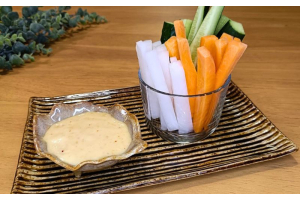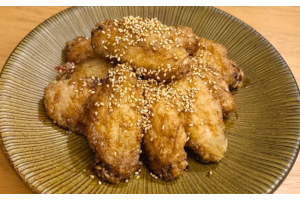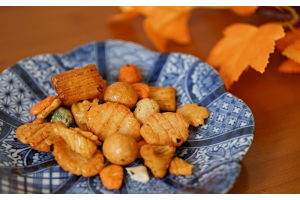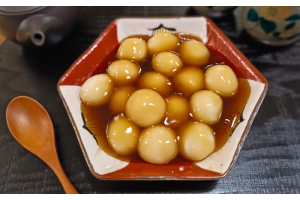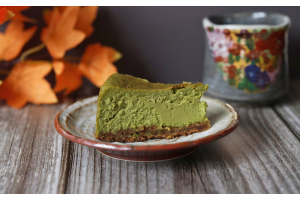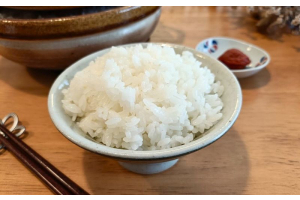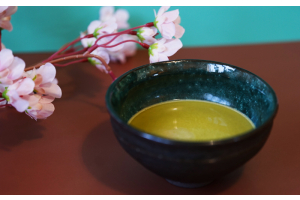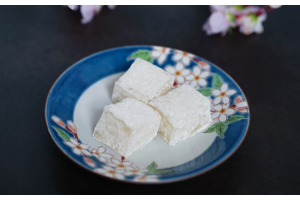We use cookies to make your experience better. To comply with the new e-Privacy directive, we need to ask for your consent to set the cookies. Learn more.
Is It Different from Molasses? Discover the Traditional Japanese Sweetener, Kuromitsu

Kuromitsu, a beloved sweetener essential to traditional Japanese sweets, is known for its rich and mellow sweetness. It enhances the flavor of classic treats like warabi mochi and anmitsu. While its appearance may resemble Western molasses, kuromitsu is quite different in terms of ingredients, production methods, and taste.
In this article, we’ll explore the history and appeal of kuromitsu, how it differs from molasses, its potential health benefits, and some popular Japanese confections that feature it. Join us as we dive into the fascinating world of this unique Japanese syrup.
The Origins of Kuromitsu
The origins of kuromitsu are closely tied to the production of kokutō (unrefined black sugar). Kokutō has been traditionally made in southern regions of Japan, particularly Okinawa and the Amami Islands. Kuromitsu is believed to have emerged as a by-product during the process of boiling down sugarcane juice to produce kokutō.
By the Edo period (1603–1868), sweeteners similar to modern kuromitsu were already in use. Historical cookbooks from that era mention such ingredients, indicating that kuromitsu-like sweeteners were part of daily life even then.
At the time, however, kuromitsu was an imported item from Ryukyu (modern-day Okinawa) and the Amami Islands, making it an expensive delicacy. It was consumed primarily on special occasions, rather than being an everyday sweetener like today. Toward the late Edo period, as merchant culture flourished and sweets shops (amami-dokoro) began appearing in the city of Edo, kuromitsu-based confections like kuzumochi, anmitsu, and warabimochi gradually became more accessible and popular among the townspeople.
The Irresistible Charm of Kuromitsu: An Essential in Japanese Sweets
The greatest charm of kuromitsu lies in its gentle yet deeply rich sweetness. Unlike the straightforward sweetness of white sugar, kuromitsu offers a mellow richness with a clean aftertaste, making it ideal for enhancing the natural flavors of ingredients. This is why it pairs so well with mildly flavored traditional sweets like warabi mochi or shiratama dango. In the world of wagashi (Japanese confections), which values the essence of each ingredient, kuromitsu is truly the perfect supporting player.
It’s also used in chilled desserts like hiyashi zenzai or tokoroten, earning a reputation as a versatile sweetener that shines in every season. Though rooted in tradition, kuromitsu adapts well to modern palates, and its popularity is steadily rising both in Japan and abroad.
In recent years, kuromitsu has been reimagined in Western-style desserts such as pancakes, puddings, ice cream, and yogurt, becoming a staple in fusion sweets. Its elegant color and aromatic depth are also among its many appealing qualities.
Popular Japanese Sweets and Dishes Featuring Kuromitsu
Thanks to its rich flavor and deep color, kuromitsu is a beloved ingredient in many traditional Japanese sweets. One of the most iconic examples is warabi mochi, a jelly-like dessert made from bracken starch and served with roasted soybean flour (kinako) and a generous drizzle of kuromitsu. The combination of soft, chewy texture, nutty aroma, and mellow sweetness makes it a favorite summer treat.
Kuromitsu is also an essential element in desserts like anmitsu and mitsumame, where it ties together a colorful mix of agar jelly, sweet beans, fruits, and mochi into a harmonious whole. In these dishes, kuromitsu acts as a subtle yet indispensable unifier.
Other traditional pairings include shiratama dango (rice flour dumplings), kuzumochi (arrowroot cakes), and chilled zenzai (sweet red bean soup). Kuromitsu’s popularity has even expanded into modern desserts—it’s now commonly used as a topping for pancakes, vanilla ice cream, and yogurt.
With just a sprinkle of kinako and a pour of kuromitsu, even the simplest dessert transforms into a distinctly Japanese delicacy. Kuromitsu is truly a versatile sweetener with endless possibilities.
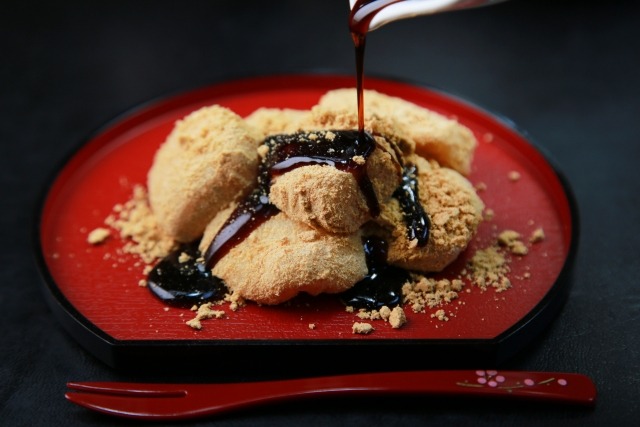
How Is Kuromitsu Different from Molasses?
Kuromitsu is a simple Japanese sweetener made by simmering unrefined cane sugar or pure sugarcane juice. The production method is natural, without additives, preserving the original minerals and rich flavor of the raw ingredients. It has a thick, syrupy texture and ranges in color from dark brown to nearly black. The taste is mellow and deep, with a gentle sweetness reminiscent of brown sugar that spreads smoothly across the palate.
On the other hand, molasses—commonly used in Western countries—is a byproduct of refined sugar production. It has a heavy sweetness with a slightly bitter undertone. There are several types, including “light,” “dark,” and “blackstrap” molasses, mainly used in baking and sauces. Rather than enhancing the flavor of ingredients, molasses tends to introduce a strong and sometimes overpowering taste, especially in darker varieties.
Although kuromitsu and molasses may appear similar, their taste, purpose, and production methods are entirely different. Kuromitsu plays a vital role in the delicate world of traditional Japanese sweets, offering a refined sweetness that highlights the beauty of each ingredient.
| Category | Kuromitsu (Japanese Brown Sugar Syrup) | Molasses |
| Ingredients | Mainly unrefined brown sugar (often from Okinawa or Amami) or raw sugar. Brown sugar is made by boiling down sugarcane juice without refining, retaining both sugar and minerals. | Juice extracted from sugarcane or sugar beets. Molasses is the liquid byproduct left after sugar (sucrose) is crystallized and extracted. Commonly produced in the U.S., Caribbean, India, and elsewhere. |
| Production Method | Brown or raw sugar is dissolved in water and gently simmered over low to medium heat until thickened. Careful temperature control is needed to avoid burning. Often handmade in households or small workshops. | During sugar production, after crystallizing sucrose from cane or beet juice, the remaining liquid is heated and concentrated. Classified into light, dark, and blackstrap molasses depending on the extraction stage. Typically produced in large sugar refineries. |
| Taste | Mild and mellow sweetness with minimal off-flavors. Smooth aftertaste with subtle richness from brown sugar. Pairs well with wagashi (traditional sweets), soy milk, pancakes, etc. | Sweet with a noticeable bitterness or tang. Has a strong and distinctive flavor. Blackstrap molasses is especially mineral-rich and can be polarizing. Used in baked goods, breads, and health foods. |
| Color | Dark brown to slightly reddish amber. Sometimes transparent; reddish tones may appear when held to the light. | Very dark brown to black, opaque, with thick viscosity. Darker and denser in color than brown sugar syrup. |
| Aroma | Gentle, sweet aroma unique to brown sugar. No burnt smell, but with subtle, toasted grain-like notes. Mild and appetizing. | Strong burnt caramel-like scent. May include sulfur or metallic (iron-like) notes depending on the type. Some varieties have an intense aroma. |
Health Benefits of Kuromitsu, Known Since the Edo Period
Kuromitsu is more than just a sweetener. One of its key advantages is its rich mineral content—especially calcium, potassium, magnesium, and iron—when compared to refined white sugar. Because kuromitsu is made using a method similar to that of kokutō (unrefined brown sugar), it retains more of the natural nutrients originally found in sugarcane.
In particular, kuromitsu contains a high amount of iron, making it a beneficial addition to the diets of those prone to iron deficiency, such as women. It may also help combat fatigue and support overall vitality.
Moreover, kuromitsu is known to have a gentler impact on blood sugar levels, causing a slower rise compared to other sweeteners. This makes it a suitable option for those looking to avoid blood sugar spikes. While moderation is always key, kuromitsu is an ideal choice for health-conscious individuals who want to enjoy something sweet without sacrificing nutrition.
Thanks to its natural origin and gentle properties, kuromitsu is gaining popularity as a wholesome alternative to refined sugars, and it’s likely to receive even more attention in the future.
Kuromitsu is more than just a sweetener—it embodies the delicate aesthetic and deep-rooted traditions of Japanese culinary culture, especially in wagashi (traditional Japanese confections).
Its gentle, nuanced sweetness enhances the natural flavors of ingredients and brings a comforting sense of calm to those who enjoy it.
Kuromitsu is also drawing attention for its nutritional value, making it a perfect choice for today’s health-conscious, natural lifestyle.
If you’ve never tried kuromitsu before, start by drizzling it over simple treats like shiratama (rice dumplings) or yogurt to experience its subtle and heartwarming taste.
We encourage you to bring the charm of kuromitsu—Japan’s own gentle sweetness—into your everyday meals and desserts!




